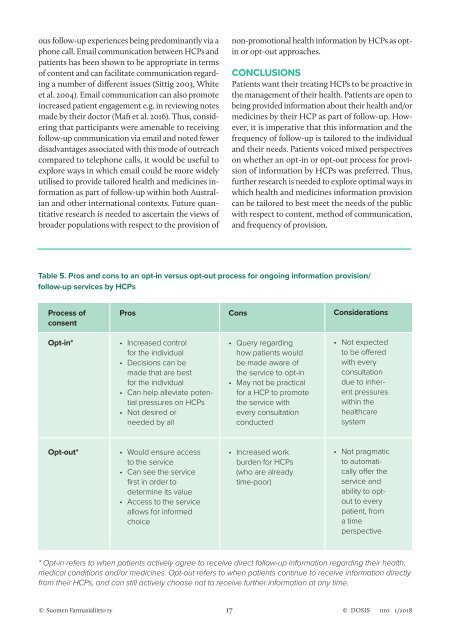Dosis 1/2018
Farmaseuttinen aikakauskirja DOSIS 1/2018 vol.43 Suomen Farmasialiitto ry
Farmaseuttinen aikakauskirja DOSIS 1/2018 vol.43 Suomen Farmasialiitto ry
- No tags were found...
Create successful ePaper yourself
Turn your PDF publications into a flip-book with our unique Google optimized e-Paper software.
ous follow-up experiences being predominantly via a<br />
phone call. Email communication between HCPs and<br />
patients has been shown to be appropriate in terms<br />
of content and can facilitate communication regarding<br />
a number of different issues (Sittig 2003, White<br />
et al. 2004). Email communication can also promote<br />
increased patient engagement e.g. in reviewing notes<br />
made by their doctor (Mafi et al. 2016). Thus, considering<br />
that participants were amenable to receiving<br />
follow-up communication via email and noted fewer<br />
disadvantages associated with this mode of outreach<br />
compared to telephone calls, it would be useful to<br />
explore ways in which email could be more widely<br />
utilised to provide tailored health and medicines information<br />
as part of follow-up within both Australian<br />
and other international contexts. Future quantitative<br />
research is needed to ascertain the views of<br />
broader populations with respect to the provision of<br />
non-promotional health information by HCPs as optin<br />
or opt-out approaches.<br />
CONCLUSIONS<br />
Patients want their treating HCPs to be proactive in<br />
the management of their health. Patients are open to<br />
being provided information about their health and/or<br />
medicines by their HCP as part of follow-up. However,<br />
it is imperative that this information and the<br />
frequency of follow-up is tailored to the individual<br />
and their needs. Patients voiced mixed perspectives<br />
on whether an opt-in or opt-out process for provision<br />
of information by HCPs was preferred. Thus,<br />
further research is needed to explore optimal ways in<br />
which health and medicines information provision<br />
can be tailored to best meet the needs of the public<br />
with respect to content, method of communication,<br />
and frequency of provision.<br />
Table 5. Pros and cons to an opt-in versus opt-out process for ongoing information provision/<br />
follow-up services by HCPs<br />
Process of<br />
consent<br />
Pros<br />
Cons<br />
Considerations<br />
Opt-in*<br />
• Increased control<br />
for the individual<br />
• Decisions can be<br />
made that are best<br />
for the individual<br />
• Can help alleviate potential<br />
pressures on HCPs<br />
• Not desired or<br />
needed by all<br />
• Query regarding<br />
how patients would<br />
be made aware of<br />
the service to opt-in<br />
• May not be practical<br />
for a HCP to promote<br />
the service with<br />
every consultation<br />
conducted<br />
• Not expected<br />
to be offered<br />
with every<br />
consultation<br />
due to inherent<br />
pressures<br />
within the<br />
healthcare<br />
system<br />
Opt-out*<br />
• Would ensure access<br />
to the service<br />
• Can see the service<br />
first in order to<br />
determine its value<br />
• Access to the service<br />
allows for informed<br />
choice<br />
• Increased work<br />
burden for HCPs<br />
(who are already<br />
time-poor)<br />
• Not pragmatic<br />
to automatically<br />
offer the<br />
service and<br />
ability to optout<br />
to every<br />
patient, from<br />
a time<br />
perspective<br />
* Opt-in refers to when patients actively agree to receive direct follow-up information regarding their health,<br />
medical conditions and/or medicines. Opt-out refers to when patients continue to receive information directly<br />
from their HCPs, and can still actively choose not to receive further information at any time.<br />
© Suomen Farmasialiitto ry 17<br />
© DOSIS nr0 1/<strong>2018</strong>

















